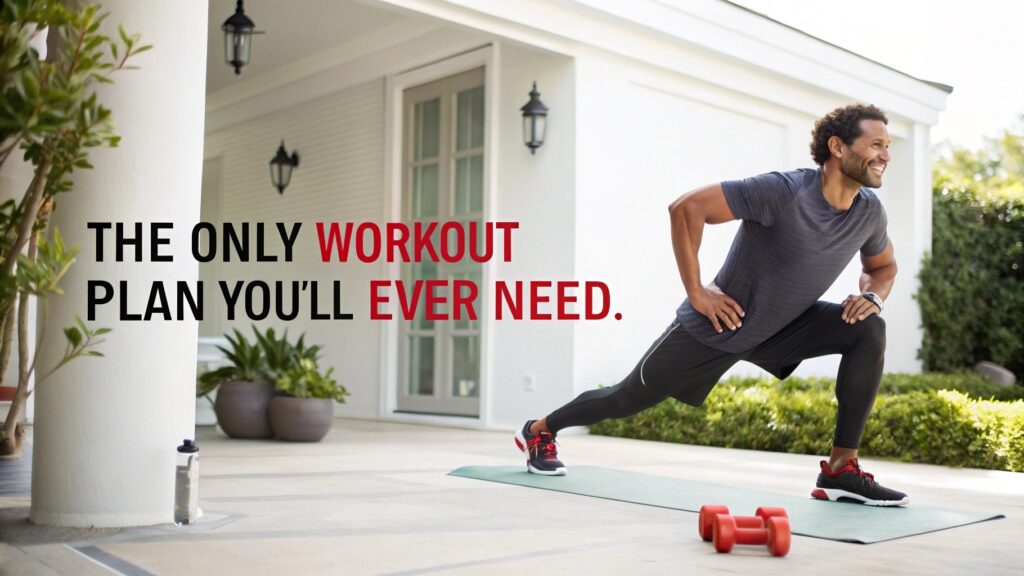Introduction
The Only Workout Plan You’ll Ever Need-Are you tired of jumping from one fitness fad to the next, only to end up right back where you started? Do you scroll through social media, overwhelmed by the endless array of complex routines promising miraculous results? It’s time to cut through the noise. True, lasting fitness isn’t found in a 30-day shred or a secret supplement; it’s built on a foundation of fundamental, time-tested principles. This article breaks down the science and strategy behind creating a sustainable, effective, and adaptable regimen—truly the only workout plan you’ll ever need.
Why Most Workout Plans Fail (And Why This One Won’t)

The fitness industry is built on novelty, but our physiology is not. Most plans fail because they are unsustainable, overly complex, or ignore individual needs. They often prioritize intensity over consistency, leading to burnout, injury, or sheer boredom. A study published in the Journal of Sports Medicine frequently highlights that adherence—simply showing up—is the single greatest predictor of long-term fitness success, not the minutiae of the program itself.
The plan you’ll ever need succeeds because it is built on pillars, not prescriptions. It’s a framework, not a rigid set of rules. This framework is anchored in four core principles: Progressive Overload, Specificity, Recovery, and Enjoyment. Think of these as your compass. Whether your goal is fat loss, muscle building, or improving athletic performance, these principles guide every decision. They ensure your body continues to adapt and improve, preventing the dreaded plateaus that derail so many well-intentioned fitness journeys. This adaptable approach means the plan evolves with you, from your first day in the gym to your thousandth.
The Foundational Pillars of a Lifelong Fitness Plan
Pillar 1: Progressive Overload
Progressive overload is the non-negotiable engine of growth. It simply means you must gradually increase the demands placed on your musculoskeletal system to make gains in muscle size, strength, and endurance. This doesn’t always mean adding more weight. You can progress by increasing the number of repetitions, the number of sets, improving your form, reducing rest time between sets, or increasing training frequency. For example, if you’re bench pressing 100 lbs for 3 sets of 8 this week, your progression could be aiming for 3 sets of 9 or 10 with the same weight next week. Once you hit 3 sets of 12 comfortably, you’d then increase the weight and start the rep cycle again. This systematic approach provides a clear, measurable path for improvement.
Pillar 2: Movement Patterns Over Muscles
Instead of thinking about working your “biceps” or “chest,” structure your training around fundamental human movement patterns. This ensures balanced strength, reduces injury risk, and builds a body that functions well in daily life. The six primary patterns are: Horizontal Push (e.g., push-ups, bench press), Horizontal Pull (e.g., bent-over rows, seated rows), Vertical Push (e.g., overhead press, handstand push-ups), Vertical Pull (e.g., pull-ups, lat pulldowns), Knee-Dominant (e.g., squats, lunges), and Hip-Dominant (e.g., deadlifts, hip thrusts). A well-rounded plan incorporates all of these throughout the week. This is far more effective than a traditional “bro split” that might neglect crucial pulling movements, leading to poor posture and muscular imbalances.
Building Your Personalized Weekly Schedule
There is no single “best” workout split; the best one is the one you can consistently follow. However, based on extensive research and expert consensus (from organizations like the NSCA and ACE), a full-body routine performed 3-4 days a week is arguably the most efficient and effective starting point for most people. It allows you to hit each muscle group frequently, which is optimal for growth and skill development.
For those with more time and experience, a 4-day Upper/Lower split is a fantastic progression. This allows for greater volume per muscle group. You would train Upper Body on Day 1 (push and pull focus), Lower Body on Day 2 (squat focus), rest, then Upper Body on Day 4 (different exercise variations), and Lower Body on Day 5 (deadlift focus). This structure provides a great balance of frequency, volume, and recovery time, making it a sustainable long-term model for intermediate to advanced lifters.
Key Components: Strength, Hypertrophy, and Recovery

A truly complete plan balances different training goals within the microcycle (your week). Strength training (lower reps of 3-6 with heavier weight) builds neuromuscular efficiency and raw power. Hypertrophy training (moderate reps of 8-12 with challenging weight) creates metabolic stress and muscle damage, leading to growth. A blend of both is ideal. You might start your workout with a heavy strength compound lift for 4 sets of 5 reps, then follow it with accessory hypertrophy exercises for 3 sets of 10-12 reps.
However, your muscles don’t grow in the gym; they grow when you rest. Recovery is the secret sauce. This encompasses sleep, nutrition, and stress management. Aim for 7-9 hours of quality sleep per night, as this is when crucial hormone production (like Human Growth Hormone) peaks. Nutritionally, ensure you’re consuming enough protein (a common target is 0.7-1 gram per pound of bodyweight) to repair muscle tissue and enough carbohydrates to replenish glycogen stores. Active recovery, like light walking, yoga, or foam rolling on rest days, can significantly enhance blood flow and reduce soreness.
Actionable Steps: Your First Week on the Plan
Ready to start? Here’s your step-by-step guide to week one. Step 1: Assess Your Equipment. This plan is adaptable. You can perform it in a fully-equipped gym or at home with a set of dumbbells and resistance bands. Step 2: Choose Your Split. If you’re new or time-crunched, start with the 3-day full-body plan. Schedule these days on non-consecutive days (e.g., Monday, Wednesday, Friday). Step 3: Select Your Exercises. Pick one exercise for each movement pattern. For a full-body day, that could be: Goblet Squats (Knee-Dominant), Dumbbell Bench Press (Horizontal Push), Bent-Over Rows (Horizontal Pull), Overhead Press (Vertical Push), and Planks (Core).
Step 4: Determine Your Sets and Reps. Start conservatively. For your first week, aim for 2-3 sets of 8-10 repetitions for each exercise. The weight should be challenging but allow you to maintain perfect form. Your goal this week is to master the movement, not max out. Step 5: Log Everything. Use a notes app or a dedicated journal to record your exercises, weights, sets, and reps. This data is invaluable for applying progressive overload next week. Did you get 3 sets of 10 on Goblet Squats with 25 lbs? Next time, try for 3 sets of 11, or move up to 30 lbs.
Adapting the Plan for Life: FAQs and Final Thoughts
Q: What if I get bored?
A: Boredom is a sign you need variation within the framework. You don’t need a new plan; you need new exercise variations. Swap your back squats for front squats for a few weeks. Change your barbell bench press for dumbbell bench press. The movement pattern (Horizontal Push) stays the same, but the stimulus feels fresh.
Q: How do I adapt this for weight loss?
A: The core principles remain identical. The primary driver for weight loss is a caloric deficit, which is achieved through nutrition. Your training supports this by preserving calorie-burning muscle mass. You might incorporate more metabolic conditioning (e.g., circuit training, sled pushes) at the end of your workouts to increase energy expenditure, but the strength training foundation should always be the priority.
Q: Is this suitable for beginners and advanced athletes?
A: Absolutely. A beginner will start with lighter weights and master the basics. An advanced athlete uses the same pillars but manipulates variables like volume, intensity, and exercise complexity to a higher degree. The framework scales infinitely.
This is more than just a workout plan; it’s an education in how your body works and adapts. By internalizing these principles—progressive overload, movement patterns, and intelligent recovery—you equip yourself with the knowledge to navigate any fitness goal for the rest of your life. You no longer need to search for the “next best thing.” You already have the only blueprint you’ll ever need.
What are your biggest hurdles with sticking to a consistent plan? Share your thoughts in the comments below—let’s build a community of support and share strategies for lifelong fitness success.



